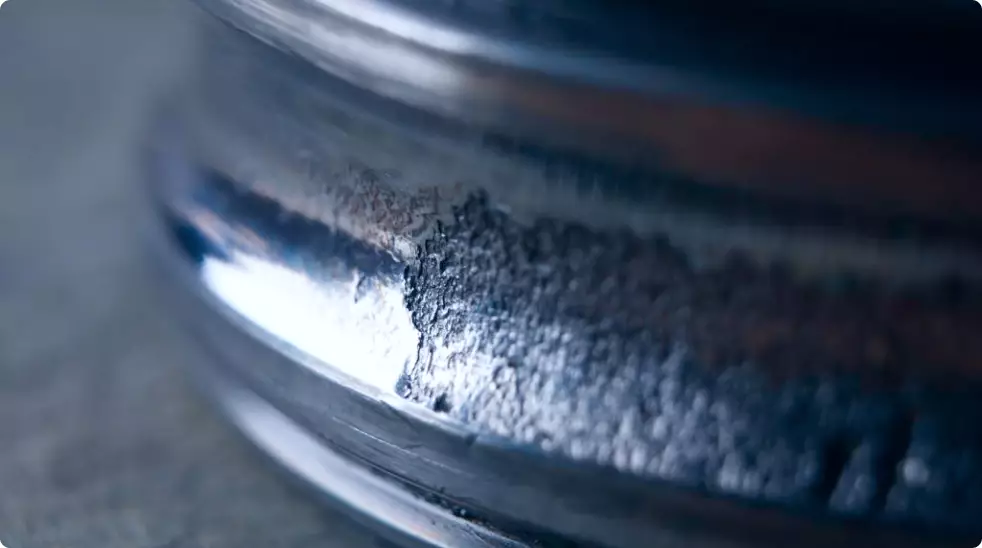
Bearing Damage and Failure Analysis
The bearing service life of a rolling bearing rotating under load can fail due to material fatigue and wear at the running surfaces of rings and rolling elements. Statistically stressed bearings may be made unserviceable by plastic deformation of the contact surfaces. Premature bearing failures are attributed to other causes.
Rolling bearing damage is generally detected by:
- Unusual operational behavior
- Noise emitting from the bearings
- High friction causes less than smooth operation
- Higher than normal operating temperatures
In practice diagnosing the primary cause of damage is not always easy because it is often obscured by consequential damage.
Examining failed bearings along with an understanding of the application parameters can lead to educated conclusions. In some cases, it may be only possible to ascertain that overheating and seizure took place. In bearings suffering lesser damage after removal conclusions can be drawn from the examination of the ball and roller pathways.
Conclusions can be reached if you understand the operating conditions, loads, and lubrication.
To list all known types and causes of bearing damage would go beyond the scope of this writing so only the most important will be discussed.
Causes of bearing damage
Plastic Deformation
Ball indentations in the ring raceway. A rolling bearing subjected to excessive loading while stationary or performing small oscillating movements becomes unserviceable due to plastic deformation at the contact surfaces. The result of these indentations is that the balls received shock or impact loads or had excessive loads. In future operations, this bearing would rotate unevenly and would generally not be fit for further service.
Wear
Wear is a common cause of bearing failure. Wear occurs mainly due to dirt and foreign particles entering the bearing. Abrasive particles such as dust, sand, and grit roughen the contact surfaces. Severe wear considerably increases the bearing clearance and changes the raceway profile.
Corrosion Damage
The result of severe rust on the running surfaces is uneven and noisy operation.
Rust particles worn off by the rolling elements have an abrasive effect and generate wear. Rust pits are the starting point for subsequent flaking. Rust forms not only when water, acids, etc, penetrate the bearing but is also promoted by acidic lubricants.
Condensation is another cause for corrosion which can occur from sudden cooling of the bearing from the operating temperature in humid air environments.
Brinelling
The raceways of correctly hardened rolling bearings occasionally show indentations regularly distributed over the entire circumference, corresponding approximately, in their shape to the Hertzian contact area. As a consequence, the bearing becomes noisy and uneven in operation.
This damage is known as brinelling and may have three possible causes:
- Indentations may be a result of static overloading
- Shock loads and vibrations and fretting corrosion or false brinelling. The removal of the material originates at the periphery of the Hertzian contact area and is a consequence of the tangential friction forces
- Bearing races showing regularly distributed indentations the third possible cause is the passage of electric current
Faulty Mounting
The position of the loading zone of a bearing is determined by the direction of the externally applied forces and conditions of rotation.
The loaded zone can be recognized even after a short running time by its dull appearance and indicated whether the bearing was loaded in an intended manner. In radial bearings, point load is indicated by a track shorter than half the raceway circumference. Radial bearings subjected to axial loads show tracking offset to the raceway center. The most frequent mounting fault excessive preloading can be recognized by the track formation.
FAG Failure Diagnosis – Guide to Troubleshooting Wheel BearingFailures and Malfunctions
For additional information please Contact us.









 Short Rigid Couplings
Short Rigid Couplings Controlflex Couplings
Controlflex Couplings Jaw Couplings
Jaw Couplings Oldham Couplings
Oldham Couplings Bearing Locknuts – TCN
Bearing Locknuts – TCN Double Wide Shaft Collars
Double Wide Shaft Collars Heavy Duty Shaft Collars
Heavy Duty Shaft Collars International Series Shaft Collars
International Series Shaft Collars Keyed Shaft Collars
Keyed Shaft Collars Mountable Shaft Collars
Mountable Shaft Collars Quick Clamping Shaft Collars
Quick Clamping Shaft Collars Set Screw Shaft Collars
Set Screw Shaft Collars Thin Line Shaft Collars
Thin Line Shaft Collars Threaded Shaft Collars – Pacific International Bearing Products
Threaded Shaft Collars – Pacific International Bearing Products Two-Piece Shaft Collars
Two-Piece Shaft Collars Friction Bearing Universal Joints
Friction Bearing Universal Joints Needle Bearing Universal Joints
Needle Bearing Universal Joints

